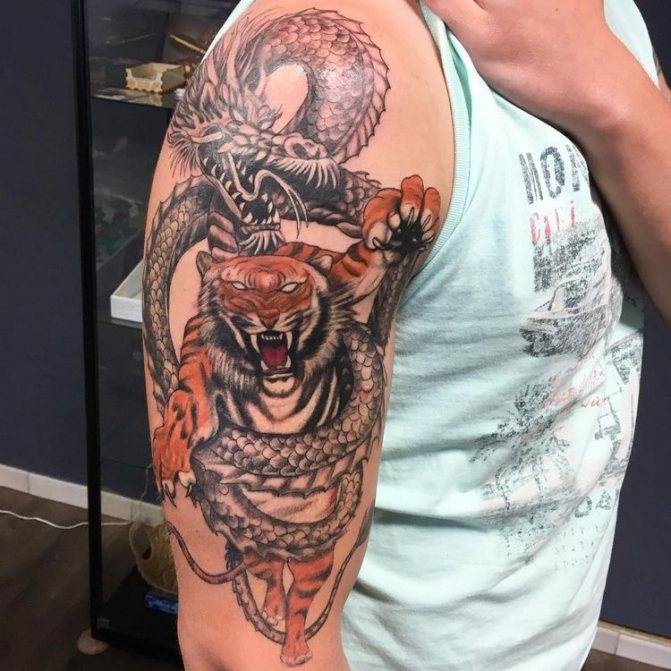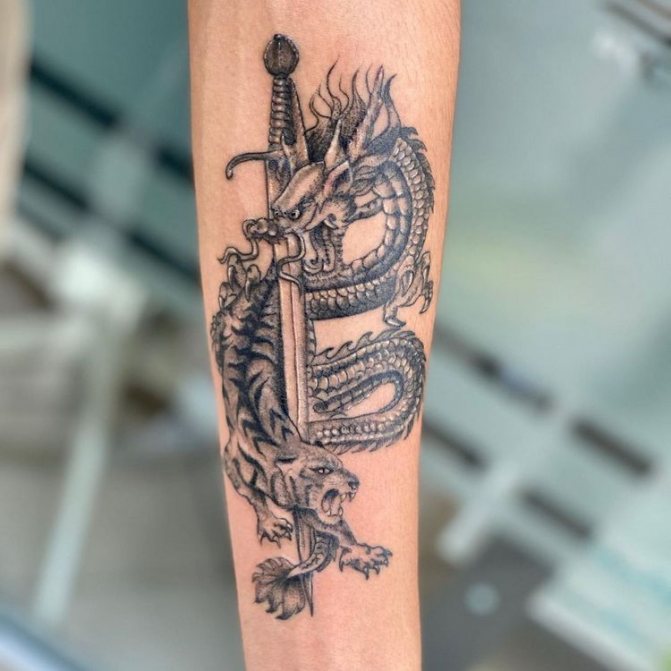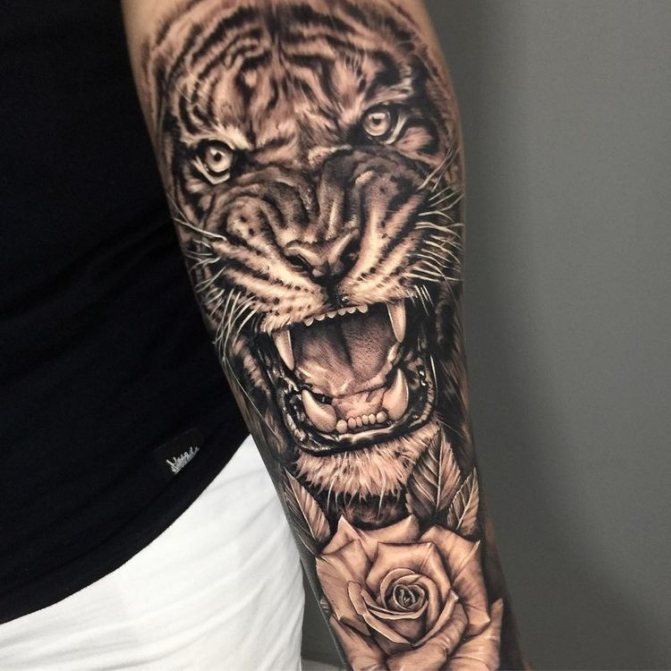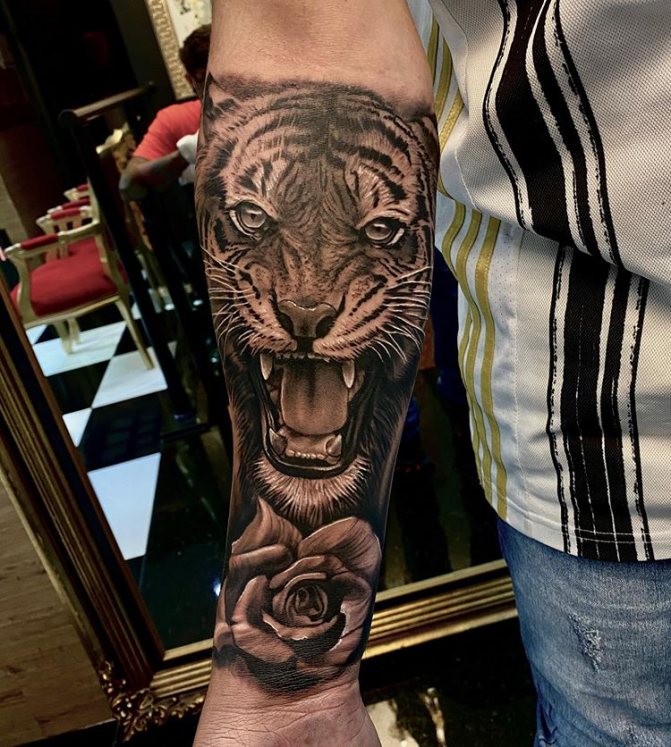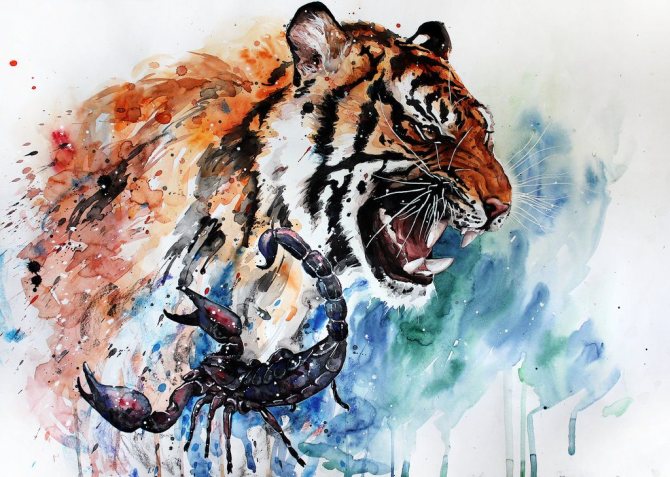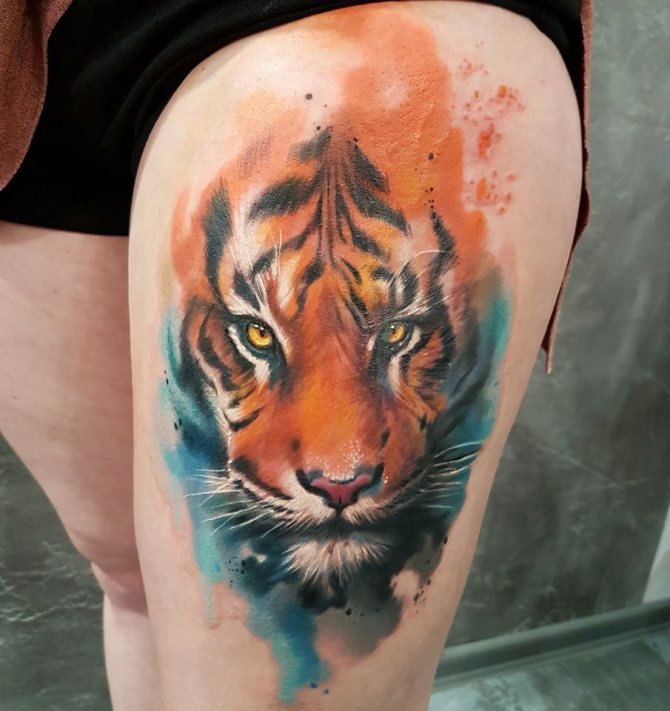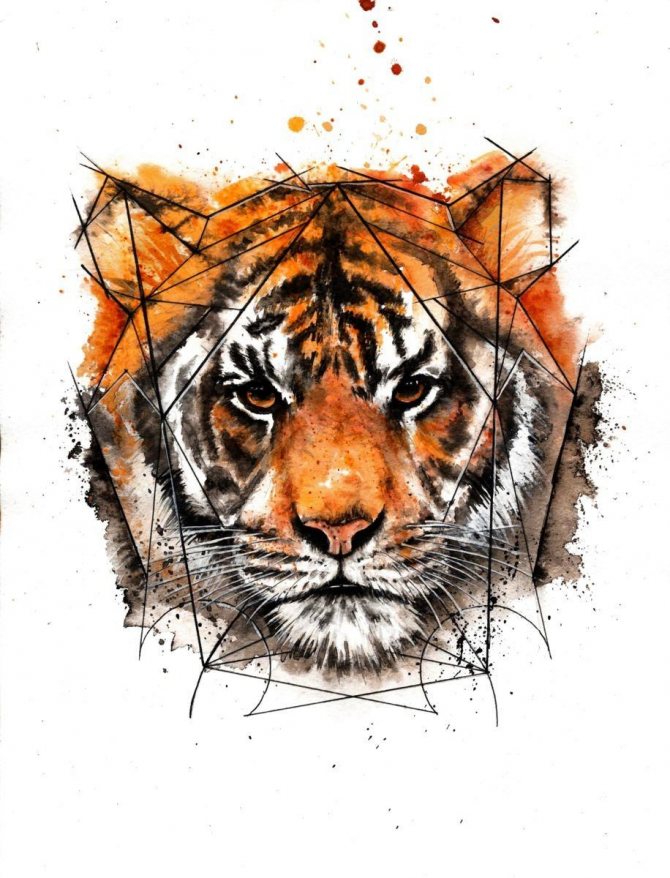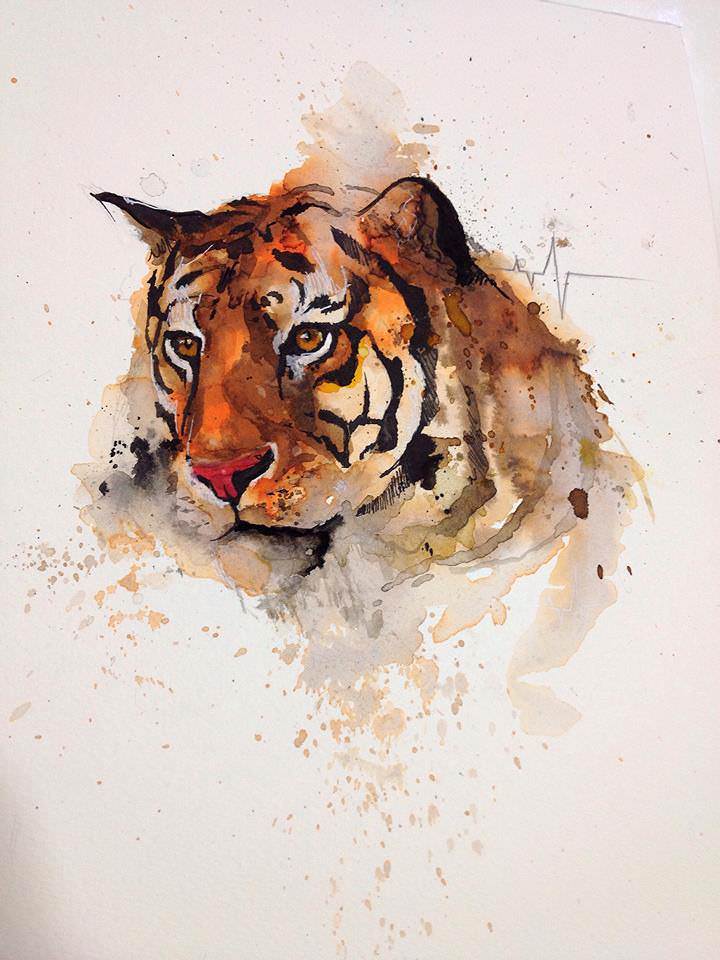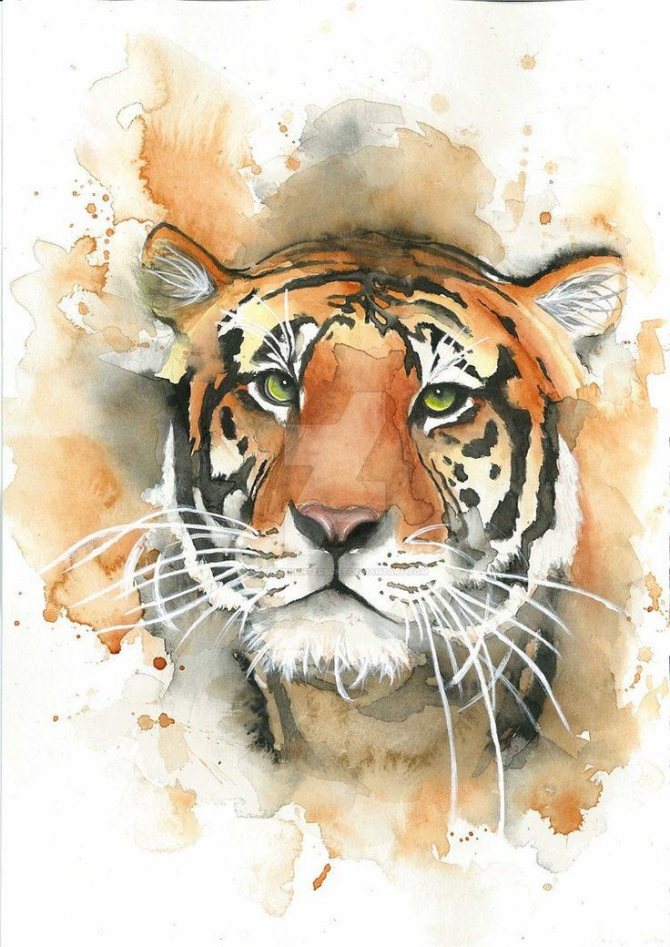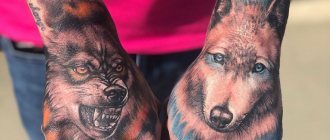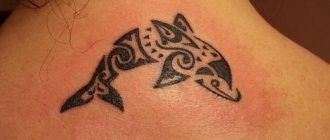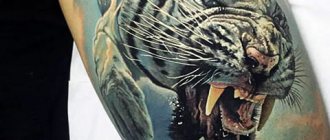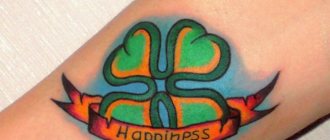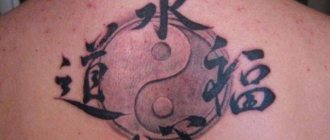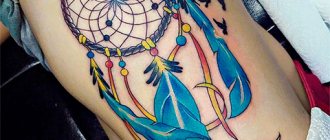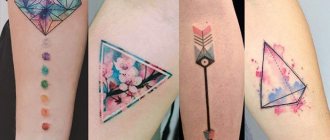Many research works have proved to us that back in the old days it was relevant to make drawings on your body. All this had a certain character, dedicated to the events that took place. Each ornament had its own kind of deciphering. For example, when a man went hunting, lines were put on his body. They signified strength, courage and bravery. Women before the wedding ceremony drew drawings denoting fidelity and obedience. A tattoo with a tiger always draws the eye of the surrounding world. We all know that the tiger is a strong and predatory animal. We offer you a brief description of all tattoos, where there is an ornament in the form of a tiger.

The meaning of the tattoo with a tiger
In the present time there is a great variety of tattoos, where the tiger figures. But not every one of us knows the symbolism and meaning of this picture. Therefore, it is worth a little talk about this ornament. For example, "Tiger white color" symbolizes the uniqueness of the owner. After all, we all know that an animal with this coloring is very rare. Apparently, that is why we do not see this image on the human body every day. It is the image of the tiger denotes courage, greatness and determination. Therefore, many men use this ornament to decorate their bodies. Thus, the male sex is trying to express their feelings and temper. But not every one of the drawings carries a positive message. When choosing a tattoo, it is necessary as carefully as possible to get acquainted with its meaning.


History of the tattoo
The tiger is a large predator of the feline family, mainly inhabiting Asia, Eastern Siberia and the Far East. To defeat the tiger in the hunt has been the dream of many warriors and hunters since ancient times, due to the great danger and complexity of such an undertaking.


In China, the tiger symbolized the forces of the night, it was a lunar animal. Apparently, from the fact that the tiger preferred to hunt at night, as well as with the coloring of the skin. In antique Europe the tiger was associated with Dionysus, the god of wine-making; it was an attribute of the deity along with a bowl and a bunch of grapes, an epicurean incarnation.
But on the whole, there is no special stable tiger context in European culture, because this animal was not widespread. Rather, it was ascribed the same qualities as all felines, only in a more aggressive version, like the lion - the size and disposition of the stern beast had an effect. The tattoo of the tiger and any images could be interpreted as the embodiment of royalty, majesty, superiority - both spiritual and physical.
Today, in a global world, different meanings permeate everywhere. We know from Indian epics, from Kipling's tale of Mowgli, from Indian legends that tigers were treacherous and dangerous predators in the jungle. However, this proud lone hunter had his own rules, which shaped the image of the bloodthirsty but peculiar beast.
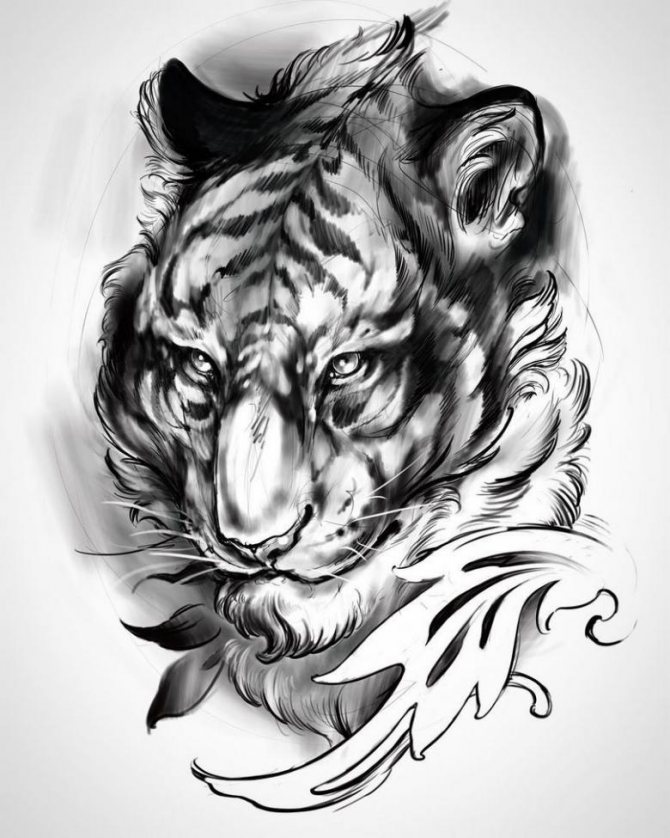

In Eastern myths, the tiger was the riding animal of the god of wealth, which attributes the predator's connection to gold and profit. For India, it is a symbol of military glory and valor, strength and power, protection from enemies, and aggression.
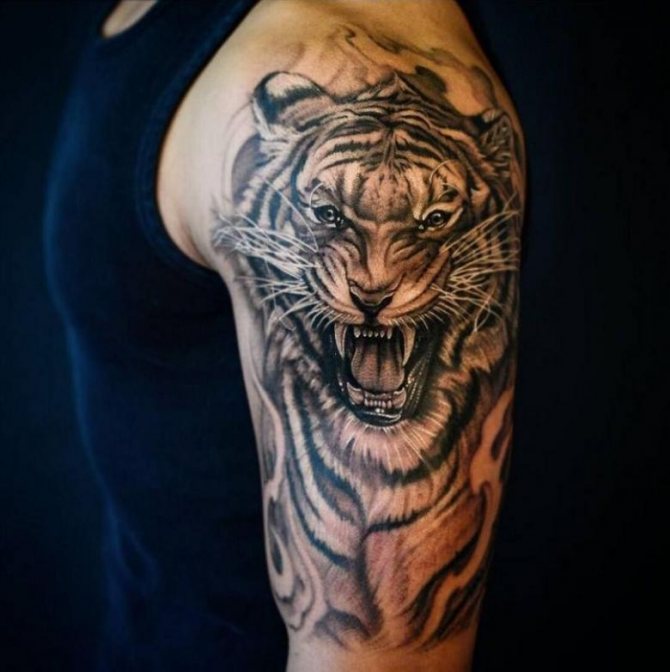

Tiger tattoo designs
If on your life path met a person who has an image of a tiger with a grin on his body, it is worth remembering that this owner of the drawing is quite an aggressive and tough personality. Agree that this figure is unlikely to choose someone who has a rather modest and simple character. When you visit a tattoo salon master will offer a variety of options for tattoos with the tiger and describe in detail their meaning, as well as introduce them to the sketches. After all, their performance options are great. The picture can contain the whole tiger, a single image of his head or eyes, tigers with the addition of flowers or other animals.
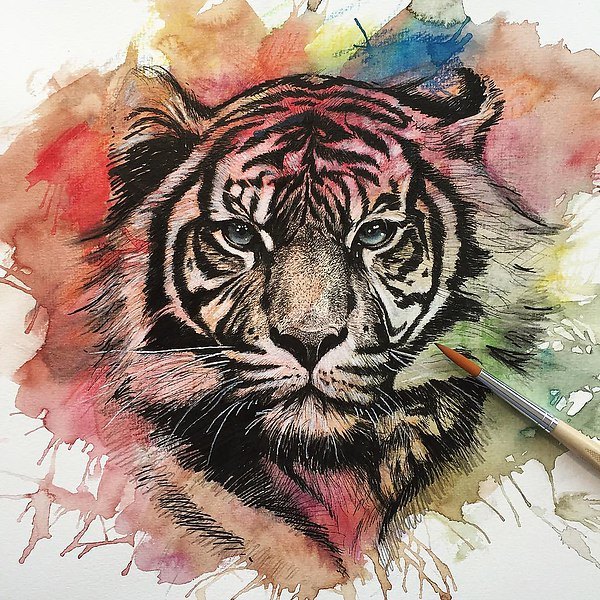

Compositions with other tattoo elements
A tiger in a cage. An image signifying that its owner or mistress wants to contain his anger and seeks to mitigate his negative character traits.
Tiger with a dragon. Such a tattoo with intertwined symbols means contentment and harmony in the soul and heart. Without them - the personification of resentment, anger and anger.
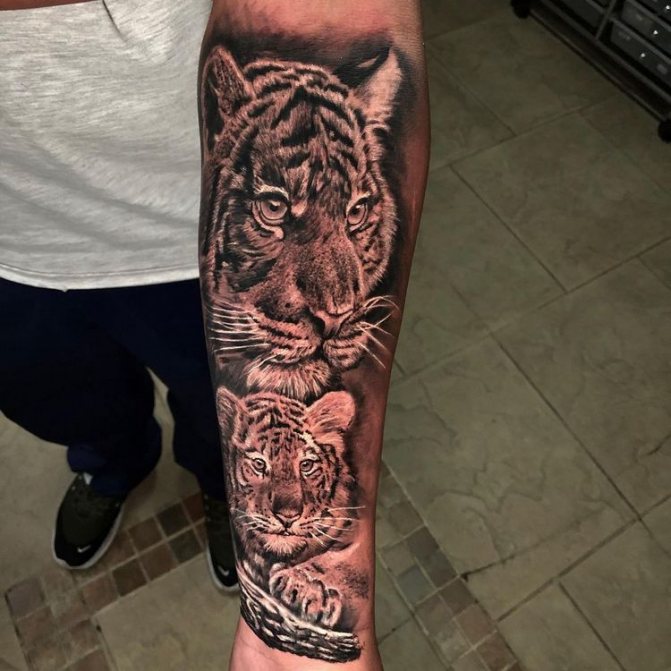

The image of a man saddled with a tiger speaks of life danger and conflict.
A mother tigress with a tiger cub. This tattoo is usually done by the fairer sex. It represents family values and motherhood. The stronger sex very rarely does such a tattoo. But if a man stuff it, it indicates that for the sake of the family, the owner of the drawing is ready for absolutely everything.
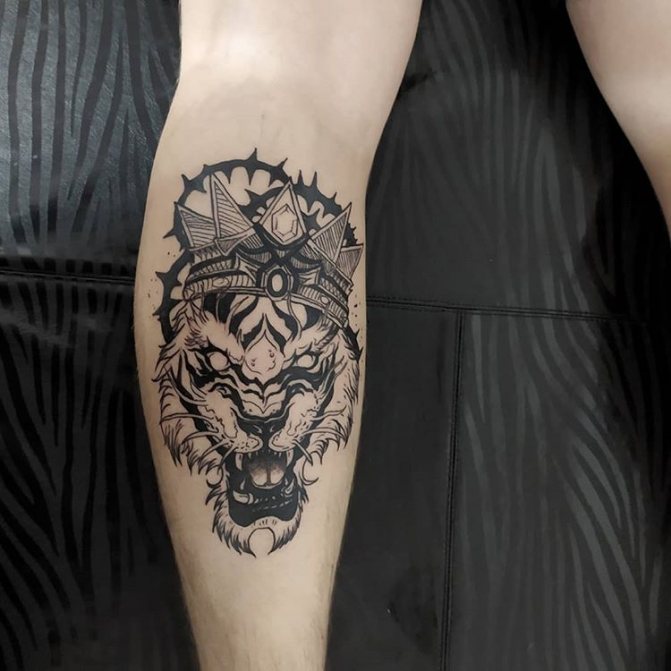

Tiger and crown. The tattoo means that the person is overbearing and has a firm character. The owners of such an image will do anything to achieve the goal, pushing aside or sweeping away any obstacles in the way. People who have chosen this composition are very persistent, determined, endowed with equanimity and cruelty.
Men's tattoos in the form of a tiger
Every representative of the stronger half of mankind tries to attract the attention of the female sex. On the hands and chest of men are often found in the form of a tiger tattoo. It is this important animal that characterizes its owner. Men with this image convey to others that they can easily stand up not only for themselves, but also for their loved ones and relatives. Tattoos in the form of a tiger performed in different techniques with additional elements. For example, a tiger with a grin or a predator licking his paw, as well as a crouching tiger. Thus it is possible to guess what kind of character a person has and what to expect from him.


Photo of the tiger skull tattoo
The skull is one of the most popular options for artistic tattooing. His image is stuffed on the skin not only men: for the beautiful half also create a lot of original sketches.
The meaning of the skull tattoo
The image symbolizes death, so many inspire fear and disgust. At the same time, the skull has long been considered a talisman from the dark forces, danger, and even from death. In tattoo styles such as old skull and chicano, popular images include Santa Muerte - the Mexican goddess of death. They depict painted female skulls surrounded by flowers.
Monochrome tattoos are designed in such styles as black&gray, realism, sketch and hipshading. Colored perform techniques in old skool, thrash polka or horror.
A big role in the sketch play details - roses, crowns, tongues of flame, daggers. They make the drawing more mystical and sinister.
On what parts of the body place the tattoo skull
Shoulders, forearms, hips, ankles are the most popular areas for both men and women. Large scale tattoos can cover the entire chest or back, or form "sleeves". Small drawings are printed also on the neck, ankles.
Especially effectively such a tattoo looks on the back of the hand, especially if the picture is made in the technique of realism. The image looks three-dimensional thanks to the skillful drawing of shadows.
The tiger is very popular among fans of tattoo art. The image of the graceful and fearsome predator printed on his skin and men and women.
The meaning of the tattoo tiger
The image of the striped predator symbolizes a fierce temper, strength, speed and grace. In the cultures of the Ancient East, the tiger was considered a military amulet. And according to the legends of Ancient Greece and China, this ferocious beast carried the gods.
The exact interpretation of the sketch depends on its design. If the tiger is depicted grinning and ready to jump, the tattoo indicates an aggressive disposition.
Other meanings of the image of this predatory beast - power, hardness of character, as well as sensuality.
Options for designing a tattoo with a tiger
The most popular sketch - a realistic image of the beast of prey, embodied in monochrome or color. The large scale obliges to stuff it on the "sleeves", shoulders, back.
Men have a popular tattoo with a tiger head, which is placed in the heart area or on the back of the palm.
Styles that are best suited for the design of such a sketch are realism, black&gray, less often - Japanese and watercolor.
Women's tattoos with a tiger
Most of the female gender prefers to perform small tattoos. Some do it specifically for their lover, and some, on the contrary, are trying to prove to the opposite sex that they are strong and brave women. That is why the tiger is a frequent pattern that you meet on a woman's body. Tattoos in the form of a little tiger cub emphasize in a girl a fragile and vulnerable character, as well as the relationship of the mother and child. Also a very famous tattoo is a tiger with a dragon. This ornament symbolizes the sign of Yin-Yang. That is the feminine principle. Tiger and is a sign of a woman or girl.
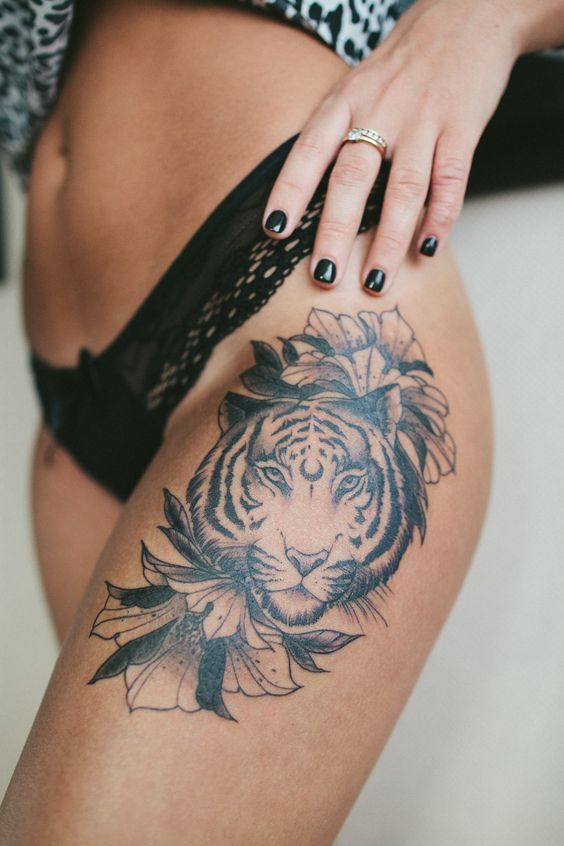

Three monkeys
Sambiki-saru or Sanzaru (Three Monkeys). The monkey has been revered in Japan since ancient times, and in Shintoism and popular beliefs, the monkey was the guardian spirit of horses. Therefore, the Buddhist respectful attitude towards the monkey was a favorite of the Japanese. It was the visual embodiment of the Buddhist principle of renunciation of the non-true and non-denial of evil, known as sambiki no saru (the image of the three monkeys). The choice of monkeys was also due to a play on words. A monkey in Japanese is "zaru" and the phrase "see nothing, hear nothing, say nothing" sounds like "mi zaru, kika zaru, iwa zaru". The meaning of this phrase is that he who does not want to see evil, hear about it, and speak about evil, will be protected from it and will not create it himself. To complete this statement, they sometimes add the image of the fourth monkey, Se-zaru ("I do not do evil"), covering the abdomen or crotch. Sambiki-saru symbolize firm adherence to Buddhist principles, integrity and purity in deeds and actions.
The mythological beast Hakutaku
The Hakutaku or kutabe (Chinese for bai chze) is a mythological beast with a human face and the body of a buffalo or lion with many eyes and horns. According to Chinese legend, this beast was encountered by the Chinese emperor Huang-di. The magical and wise beast told the emperor that only he was the greatest and wisest ruler. This legend became popular in Japan, where there are their own versions of encounters with this creature. For example, Hakutaku, told the emperor about the existence of 11 520 demons - yokai, because only he had full knowledge of them, and taught how to deal with the unclean force. In addition, this creature was able to predict unfavorable years for the crops.
Namakubi
In the ancient times, taking the head of an enemy as a trophy was a sign of respect for his person as well as an indication of the courage of his conqueror. In ancient times, taking the head of an enemy as a trophy was a sign of respect for his person as well as an indication of his victor's courage. In a tattoo, a severed head can have many meanings - it is a respect for the enemy, a warning, and an indication of bravery. However, more often than not, it simply depicts overcoming fear of the hardships of life. A popular explanation of such a tattoo is the willingness to accept any fate without complaint and with honor. Nevertheless, images of severed heads are often striking in their brutality and realism, but this is not only done to shock the viewer, it is also seen as an essential element of the wheeling of life - accepting life as it is, without embellishing reality. The display of severed heads in Japan's past was part of the festivities following victory, and Japanese heroic epics contain descriptions of such head displays. Samurai could take the heads of enemy warriors they had killed and present them as tribute to their leader. In major battles, a victorious army could collect hundreds of enemy heads. The heads of ordinary warriors would pile up and form pyramids of grim trophies. But the severed heads of honorable enemies were treated with respect and special care. For example, when Yoritomi in 1189. ordered to kill his half-brother as a traitor, his head was carefully washed and placed in a lacquered box filled with sake for better preservation. Although the purpose of such an exhibition of heads was to identify slain enemy commanders, its main significance was to demonstrate the leader's military successes and the loyalty of his vassals. The severed head of an enemy leader symbolized the vassal's supreme loyalty to his lord, as he would risk death to acquire such a trophy. The samurai, presenting such "gifts" to his lord, could count on his special appreciation. On the other hand, by accepting them, the victorious warlord demonstrated his superiority over the leaders of the enemy whose vassals had failed to secure victory or protect them in battle. But beyond this, beheading was a common form of punishment in Japan, sometimes for very minor transgressions. The samurai were often allowed to behead their own soldiers who cowardly fled the battlefield. Beheading (without seppuku) was considered a very severe and degrading form of punishment. One of the most brutal beheadings was carried out on Sugitani Zenjubo, who attempted to assassinate Oda Nobunaga, a famous daimyo in 1570. After his capture, Zenjubo was buried in the ground and only his head was outside, and it was sawed off with a bamboo saw for several days. Such punishments were abolished at the beginning of the Meiji period.
Beheading was also historically carried out as a second step in seppuku (ritual suicide by opening the stomach). After the suicide victim cut open his own stomach, another warrior would stab him in the back of the neck with a katana to hasten death and reduce suffering. Since this ritual required the observance of certain rules, only very skilled warriors were chosen as assistants in beheading, giving them special honor. At the end of the Sengoku period, the rules were somewhat simplified and beheadings could be performed as soon as the person making harakiri inflicted a minor wound on his stomach.
Also read on our site: Karp Koi Japanese Tattoo Designs| Japanese Tattoo Designs
A severed geisha head. The following legend can be cited as an explanation for this tattoo. Geishas in former times were forbidden to marry and cohabit with Buddhist monks. But one of them broke the ban when she fell in love with a monk and shared her love, even though she knew that the punishment would be death. When the secret was discovered, the geisha was beheaded. Based on this, the tattoo can be "read" as a willingness to make any sacrifices in the name of love.
Japanese Masks
The masks used by actors of the Noh theater and the Kögen farce theater. Images of these masks are very common in irezumi stories as amulets.
Hettoko Mask
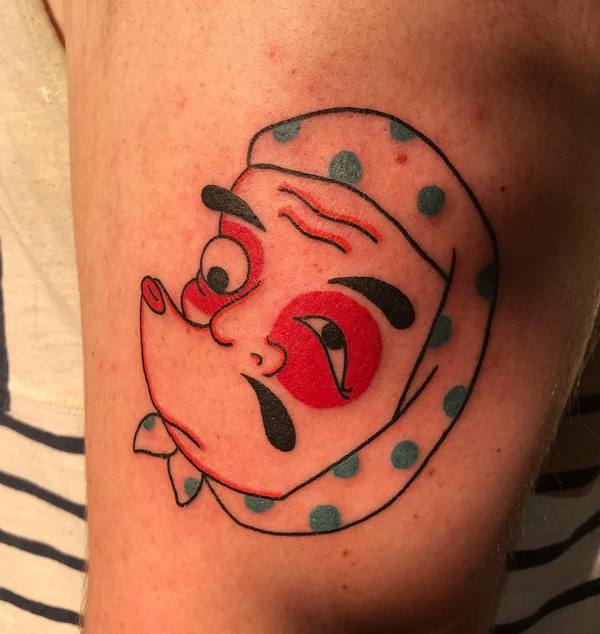

Hettoko is the name of a traditional Japanese mask depicting a funny male face. Some masks have different sized eyes, puffed cheeks, a mouth stretched into a tube as if to whistle, and a scarf, usually white with blue polka dots, wrapped around the head. The mask is used both at folk festivals and in the Kögen Theater, where it shows a comic character, a lover of revelry and unbridled merriment. The Hettoko mask is also associated with the Japanese domestic spirits of hearth and family well-being. Therefore, the Japanese often keep such a mask in their homes.
Okame Mask
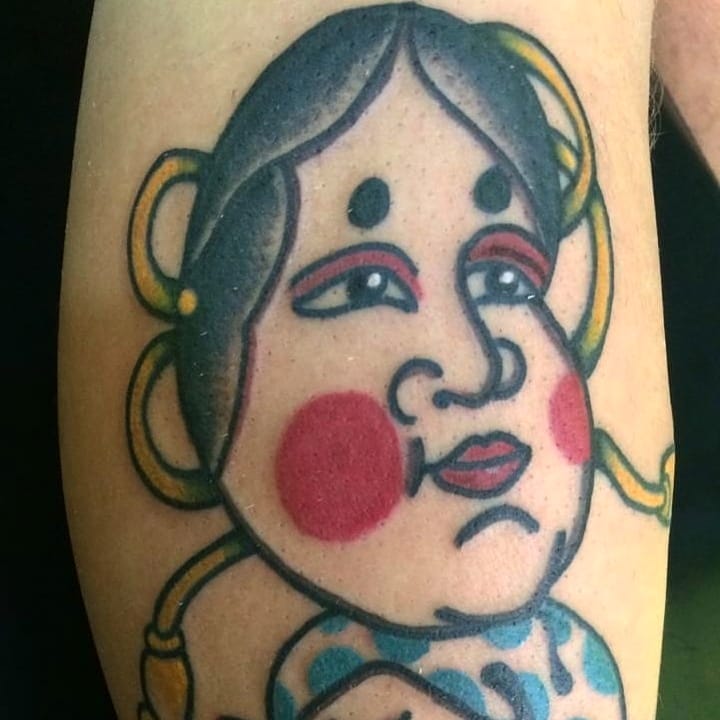

Okame or Otafuku is a mask of a woman showing a funny cheeked face. The mask symbolizes happiness and contentment, and in the farce Kögen, the actor wearing this mask portrays a kind and cheerful character. The very name of the mask, okame, comes from the Shinto goddess of joy and laughter.
Ju-men mask
Tattoos with deities: the noh and gyeogen noh masks are designed for roles in which deities are shown to the people in the image of good elders. Shown is the mask of Okin, a heavenly deity symbolizing peace and prosperity. This character is a kind of good Santa Claus from Russian fairy tales.
Tengu Mask
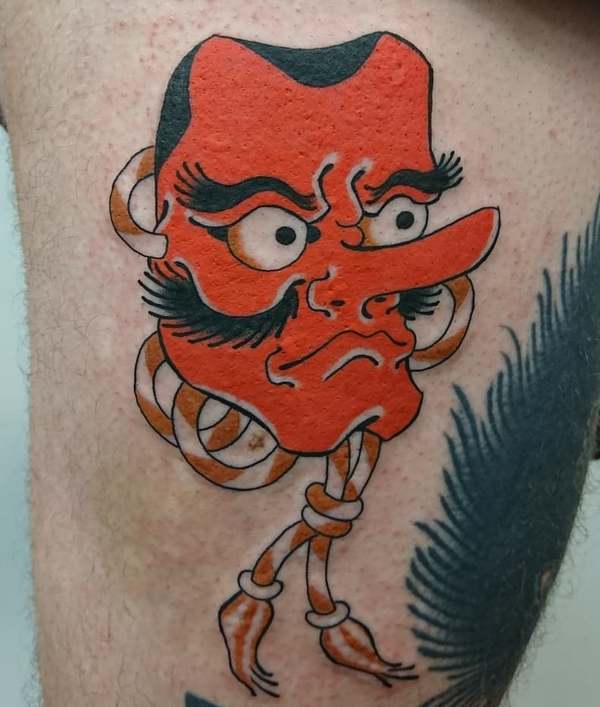

The tengu mask depicts a fairy tale character with supernatural powers. This mask is also used to point out the negative traits of the character's character - his excessive self-confidence, boastfulness and pompousness.
Beshimi Akujo Mask
The mask of "Beshimi-akujo," the old ferocious leader of the long-necked tengu from the Noh Theater productions.
Karasu-tengu mask
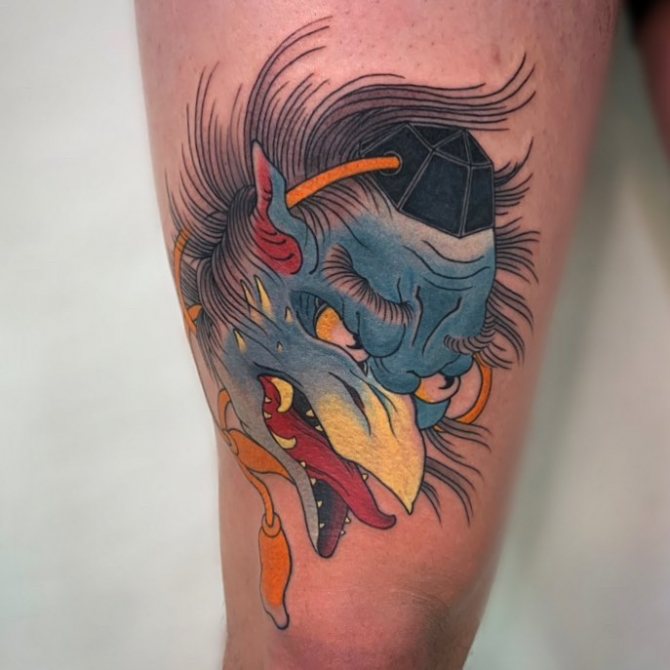

The mask of the karasu-tengu in Noh Theater.
Onryo mask


Onryo (vengeful spirit) masks are used in Noh Theater. Among these characters, the most famous of the Japanese tattoos is the "Hannya" mask, depicting a vengeful ghost that a jealous woman has turned into.
Body parts where you can get a tiger tattoo
If you want to apply yourself a tattoo with the image of this beast, then it is worth to place it on the part of the body, where the picture will look original and harmonious. This ornament should be made in a more volumetric version, otherwise its beauty will be lost, and it will look vague. The crouching tiger is often drawn on hands and feet. If it's a leg, the tiger is positioned towards the knee, and if it's a hand, then towards the wrist. Many people want their "guard" to flaunt on the shoulder, and his body down to the elbow. This option looks mysterious. Peeking out tiger's muzzle from under the short sleeve of the shirt gives a playful and somewhat dangerous image. Most girls tattoo with a tiger do on the waist. Fans of extreme and extraordinary acts prefer to do this type of ornament on the neck.
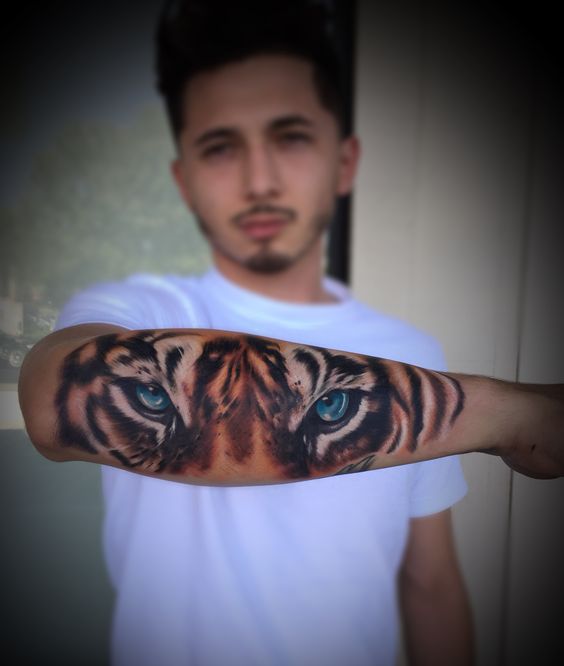

Place and nature of the tattoo
Often tattoos are applied to places that are easily concealed by clothing. Tattoo of the tiger on the chest of the man, which photo is below, an excellent example of that. An interesting fact: the image of the predator's muzzle is a symbol of passion and intelligence. A tiger in a cage indicates that a man is able to keep his emotions under control.
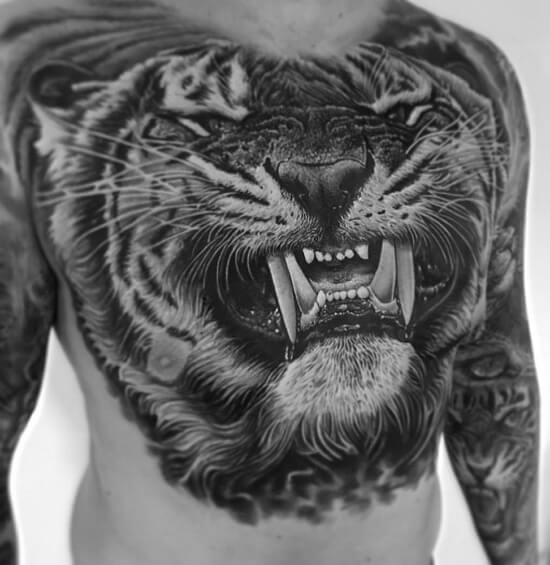

Only you decide whether the depicted tiger will be small or imposing size. Quite well look large tiger tattoo on the shoulder, which photo is in the article. You can leave the drawing in black and white or add colors.
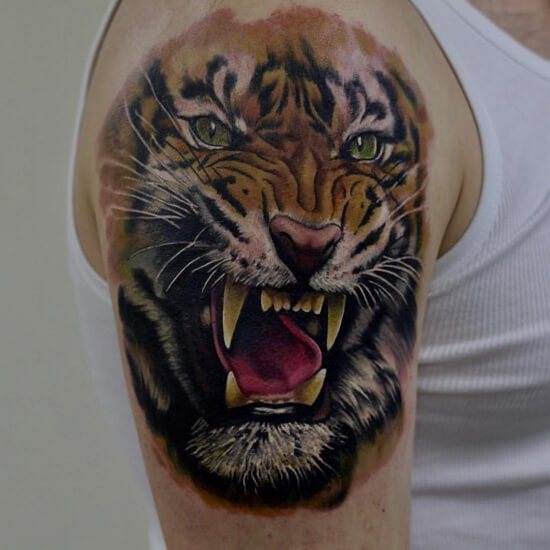

By the way, the animal does not necessarily have to be one. For example, a combination of a dragon and a tiger is very common. Together they mean the two forces, Yin and Yang. It symbolizes the inner harmony of a person. Girls often choose the tiger tattoo with tiger cubs. And tigers denote existing or planned children. Another female option is the tiger, decorated with flowers. The cute little tiger cub will be a symbol of playfulness and children's spontaneity.
The image of the animal in full size, will show all its beauty. It can be a crouching tiger or a predator in a jump. It is important to realistically convey the gracefulness of this big cat. Always spectacular looks a tiger on the hand-tattoo, the photos allow you to make sure of it.
Watercolor technique of tattooing
Many masters perform their work with the help of watercolor technique, as with this variant it is best to convey the saturated tones and emotions of the picture. For example, tattoo in the form of a tiger is performed in orange hues. Thus, not only the color of the animal, but also the grandeur of the ornament is transferred. The bright orange hue mixed with black will perfectly emphasize the image of a determined and characterful man.
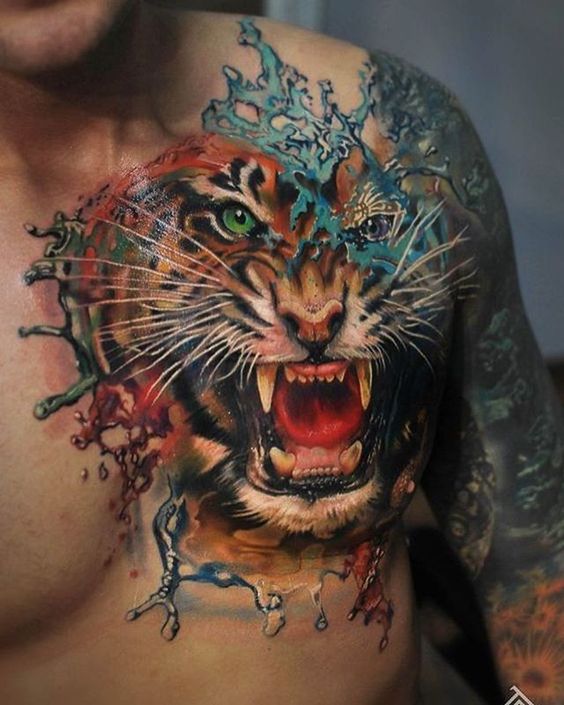

The meaning of the tattoo in the prison world
The tattoo "tiger grin" meaning in prison acquires a slightly different meaning than in freedom. Prisoners adorned themselves with it as a sign of disagreement with the system and dissatisfaction with the authorities. They were also the sign of a person ready to stand up for himself, his family and friends.
People who have been incarcerated tend to use black, gold and yellow for tattoos. Individuals with such tattoos are usually ready to do any order of the ringleader and are capable of violence.
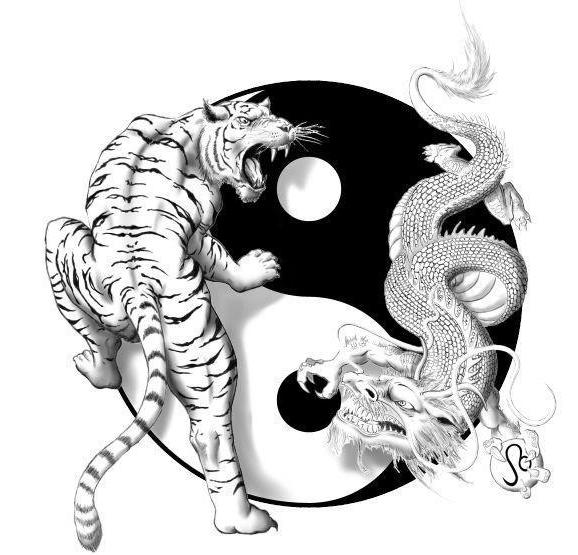

Tiger" tattoo with a background
Each person has his own views on tattoos. Someone likes black and white tattoos, and someone prefers quite colorful drawings. Therefore, masters of tattoo parlors offer to make tiger tattoos on colorful backgrounds, which will serve as a great decoration. For example, shades of earth and sky (green and blue background) or floral designs.
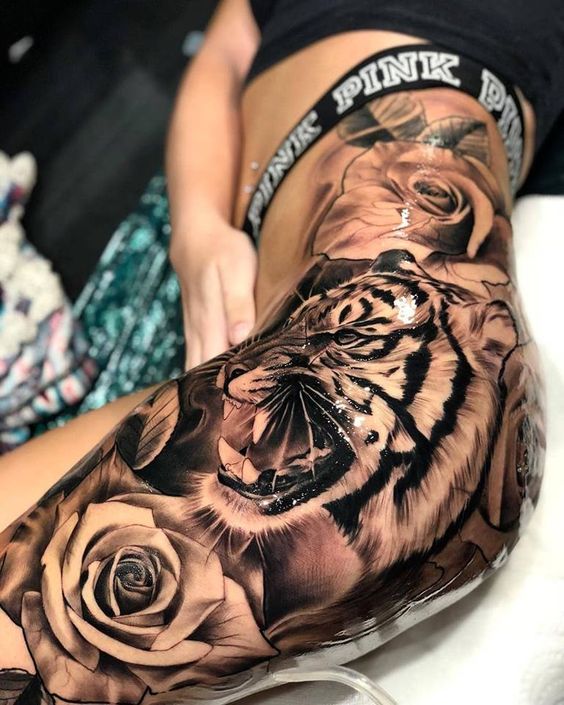

Most people think that tattoos are done only by those who want to draw attention to themselves. No, this is absolutely not the case. A person who does a tattoo is trying to show everyone his worldview and his views on the world. For example, if a girl will have a tattoo in the form of a colorful tiger, it does not mean that with the help of paints she wants to attract attention. In this way, a young beauty is trying to convey to the people around her, that she is a confident person.
Tigers in ancient cultures
The source of the interpretation of body art is often the role that the object plays in the culture of the peoples of the world. Most historical references suggest that the tiger has always been revered for courage and determination. In Asian countries this animal, by analogy with the lion, is considered the King of Beasts, which gave it the appropriate characteristics.
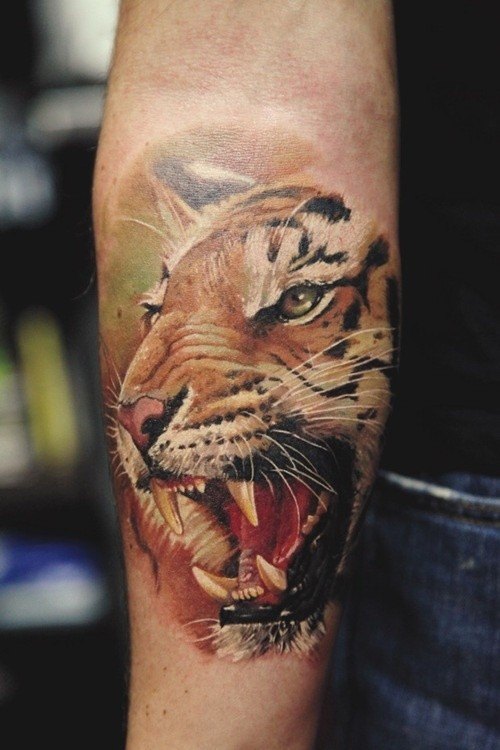

In Chinese legend, there are five tigers endowed with miraculous powers that allow them to protect the world. Some deities are depicted together with tigers, giving the animals a sacred significance. It is also believed in China that the tiger is endowed with the power to punish sinners and only attacks them.
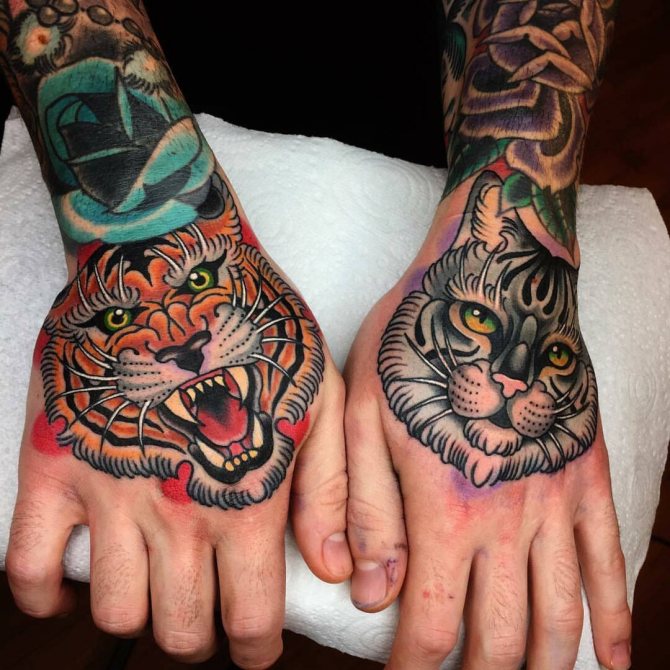

Indian military emblems depict the predator as a sign of military valor. Thailand has chosen other qualities for the animal - here the tiger symbolizes passion and sensuality. The Japanese samurai bring good luck and happiness. Western culture does not pay much attention to tigers, but they are mentioned in literature in connection with religion and the gods.
A quality-made image of a tiger on the skin always looks aesthetically pleasing. The tattoo will be bright and memorable. The variety of subjects and the ability to add any detail you like to the sketch makes such tattoos unique and distinctive.
